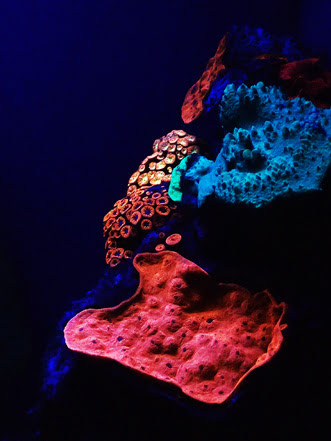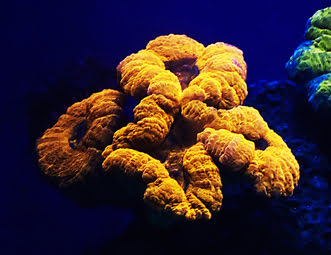Deep-water corals recently discovered in the Red Sea display a surprising array of colors, the mechanisms of which could be developed into new bioimaging tools.
An international team of researchers studied corals at depths of more than 50 m and found that many of them glow brightly with fluorescent colors ranging from green to yellow to red.

This image shows the fluorescence of corals commonly found in mesophotic reefs of the Red Sea. Images courtesy of Jörg Wiedenmann.
The corals' shallow-water counterparts in the same reef contain only green fluorescent pigments, which can act as sunscreens for the corals and their symbiotic algae. Finding similar pigments in depths where corals are struggling to collect enough light to sustain the photosynthesis of their algal symbionts (a vital energy source for the corals) was therefore unexpected.
"Since only the blue parts of the sunlight penetrate to depths greater than 50 meters, we were not expecting to see any red coloration around," said Gal Eyal, a doctoral candidate at the Interuniversity Institute for Marine Sciences. "To our surprise, we found a number of corals showing an intense green or orange glow. This could only be due to the presence of fluorescent pigments."
This type coral is not well studied because it lives below the depth limits of standard Scuba diving techniques. Advances in technical diving have enabled study in deeper waters, the researchers said.

Cecilia D'Angelo, a senior research fellow at the University of Southampton in the U.K., has studied light-dependent corals in the university's experimental aquarium.

This Lobophyllia coral can change from green to red when exposed to violet light.
"In many shallow-water corals," she said, "the production of the pigments is tightly controlled by the amount and color of the incidental light. In the majority of our deep-water species, the pigment production is essentially independent from the light exposure of the coral animals. We found, however, that some of the pigments of these corals require violet light to switch from their nascent green color to the red hue of the mature pigment."
Southampton professor Jörg Wiedenmann said the deep-water corals' optical properties "potentially make them important tools for biomedical imaging applications, as their fluorescent glow can be used to highlight living cells or cellular structures of interest under the microscope. They could also be applied to track cancer cells or as tools to screen for new drugs."
The research was published in PLOS One (doi: 10.1371/journal.pone.0128697).
For more information, visit www.southampton.ac.uk.